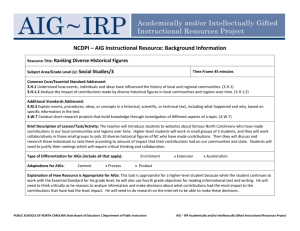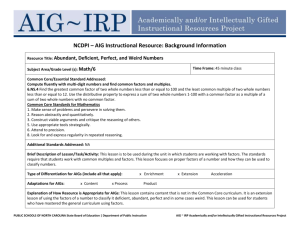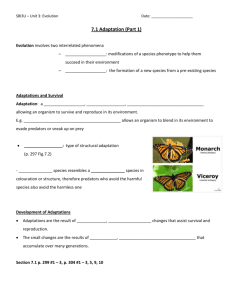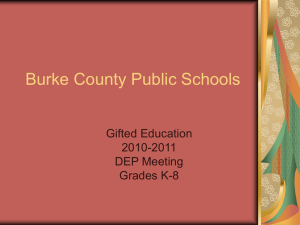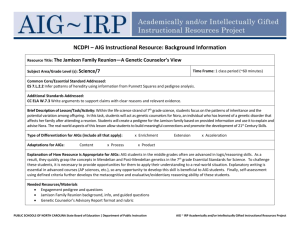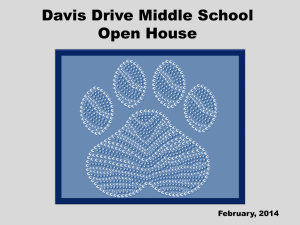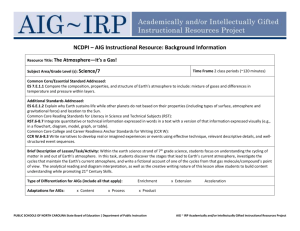SCIENCE.Grade7.EnvironmentalChanges
advertisement
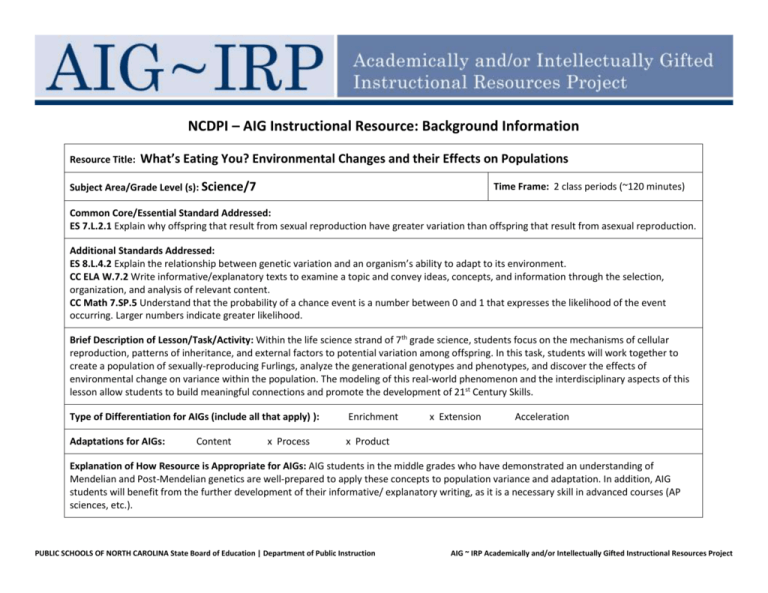
NCDPI – AIG Instructional Resource: Background Information Resource Title: What’s Eating You? Environmental Changes and their Effects on Populations Subject Area/Grade Level (s): Science/7 Time Frame: 2 class periods (~120 minutes) Common Core/Essential Standard Addressed: ES 7.L.2.1 Explain why offspring that result from sexual reproduction have greater variation than offspring that result from asexual reproduction. Additional Standards Addressed: ES 8.L.4.2 Explain the relationship between genetic variation and an organism’s ability to adapt to its environment. CC ELA W.7.2 Write informative/explanatory texts to examine a topic and convey ideas, concepts, and information through the selection, organization, and analysis of relevant content. CC Math 7.SP.5 Understand that the probability of a chance event is a number between 0 and 1 that expresses the likelihood of the event occurring. Larger numbers indicate greater likelihood. Brief Description of Lesson/Task/Activity: Within the life science strand of 7th grade science, students focus on the mechanisms of cellular reproduction, patterns of inheritance, and external factors to potential variation among offspring. In this task, students will work together to create a population of sexually-reproducing Furlings, analyze the generational genotypes and phenotypes, and discover the effects of environmental change on variance within the population. The modeling of this real-world phenomenon and the interdisciplinary aspects of this lesson allow students to build meaningful connections and promote the development of 21st Century Skills. Type of Differentiation for AIGs (include all that apply) ): Enrichment Adaptations for AIGs: x Product Content x Process x Extension Acceleration Explanation of How Resource is Appropriate for AIGs: AIG students in the middle grades who have demonstrated an understanding of Mendelian and Post-Mendelian genetics are well-prepared to apply these concepts to population variance and adaptation. In addition, AIG students will benefit from the further development of their informative/ explanatory writing, as it is a necessary skill in advanced courses (AP sciences, etc.). PUBLIC SCHOOLS OF NORTH CAROLINA State Board of Education | Department of Public Instruction AIG ~ IRP Academically and/or Intellectually Gifted Instructional Resources Project Needed Resources/Materials: Illustrations of light and dark peppered moths “Mother” Chromatin strips on pink paper “Father” Chromatin strips on blue paper Post-Its Chart Paper pre-labeled for histograms Coins Reinforcement Activity such as “A Bird’s Eye View of Natural Selection” at http://www.techapps.net/interactives/pepperMoths.swf Computers with internet access or SmartBoard use. Sources: “Peppered Moths: Natural Selection in Black and White” at http://www.techapps.net/interactives/pepperMoths.swf provides background information and a possible engagement Biology Alliance of Northern Kentucky’s “Genetic Variation Lesson” at http://www.nku.edu/~bowlingb2/GeneticVariationLesson.html suggests the use of coin-flipping to determine the allele that is passed from the parent to the offspring and also to determine the survivability of an organism in a given environmental situation – specifically in relation to sickle cell genes and malaria. TEACHER NOTES: Some prerequisite knowledge/skills are required. Students should have been previously exposed to mitosis and meiosis processes of reproduction. Students also should have been exposed to different genetic inheritance patterns (dominant, recessive, sex-linked, incomplete- or co-dominance) in order to successfully determine the phenotypes of the population. NCDPI AIG Curriculum Resource Outline STAGE ONE: ENGAGE DAY ONE: Show the illustrations of the light- and dark-colored peppered moths to students. Explain to students that light-colored peppered moths were found throughout England, with the first documented dark-colored peppered moth sighting in 1848. In the subsequent 50 years, sightings of light-colored moths became the rarity as the dark-colored moth population underwent tremendous growth. State that the change in the peppered moth population was the result of both genetic and environmental changes. Over the next two days, students will complete activities designed to help them formulate ideas about this real-world example using the fictional example provided, the Furlings. PUBLIC SCHOOLS OF NORTH CAROLINA State Board of Education | Department of Public Instruction AIG ~ IRP Academically and/or Intellectually Gifted Instructional Resources Project STAGE TWO: ELABORATE Provide students with a key to the trait alleles for the Furlings. If necessary, review the genotype/phenotype combinations with student input, emphasizing the Mendelian (simple dominance) and Post-Mendalian (incomplete, co-dominance, and sex-linked) traits and their differences. Have students select one chromatid strip from the pink “mother egg” pile and one from the blue “father sperm” pile to simulate the fertilization process that occurs with the sex cells formed through meiosis. Students should then record and identify the resulting offspring’s genotypes and phenotypes in a chart in their notebooks. Once students have identified the genotypes/phenotypes of their Furling offspring, have all students in the class stand. Choose one homozygous phenotype from each trait to call out and have students sit down as they no longer have the phenotype stated. See how many students are eliminated by the end. Explain that this demonstrates the variance found within the population since each Furling had a different “parent” providing half of its genetic composition—reinforcing the Law of Chromosomal Inheritance. In addition, ask specific students to stand (based on the earlier results) and state whether they were homozygous or heterozygous for different traits—reinforcing the Law of Independent Assortment. Next, explain that population data will be now be gathered. On the 1st piece of chart paper, labeled “F2 Generation Histogram,” students should place a post-it note in the correct column representing each of their offspring phenotypes. Ask students if they have noted any patterns that appear in the Furling population in relation to the Punnett Squares that they have completed in the past. In the majority of instances, students note the similarity of the population results to the 75%-25% split between the dominant and recessive phenotypes of simple dominance (Mendelian) genetics, the 25%-50%-25% split of incomplete dominance phenotypes with a blend, the 25%-50%-25% split of co-dominance phenotypes with both traits expressed, and the 50%-50% split of gender. Guided questions may be necessary, such as “If _____ of _____total were _________phenotype, what percentage would that be? “Based on your earlier study of genetics, why do you think the ____________ phenotype was seen ____% of the time in the Furling population?” Students should then work in partners to create the F3 generation—one male Furling and one female Furling. Each student should flip a coin to determine whether s/he is providing the first allele (heads) or the second allele (tails) from each pair to the resulting offspring. After the first F3 offspring’s genotypes/phenotypes are recorded in a notebook table, the second partner should repeat the process. Both new F3 offspring’s phenotypes should be reported out to the class through the use of post-it notes on a 2nd piece of chart paper labeled “F3 Generation Histogram.” Once all post-it notes have been placed on the histogram, ask students to compare the F2 and F3 generation histograms. In the majority of instances, students should note that the percentages remain fairly consistent, although some small fluctuations are likely. For tomorrow’s class, ask students to brainstorm ideas for why the population of the light-colored vs. dark-colored peppered moths changed dramatically. PUBLIC SCHOOLS OF NORTH CAROLINA State Board of Education | Department of Public Instruction AIG ~ IRP Academically and/or Intellectually Gifted Instructional Resources Project DAY TWO: Ask students to share their ideas to explain the significant change in the peppered moth population. After students have shared their ideas, explain that the Industrial Revolution caused air pollution that resulted in black soot deposits on buildings, trees, and other stationary objects over time. Light-colored moths now stood out against the environment and were easily seen to be eaten by birds, eliminating the possibility of passing on their light-colored genes to the next generation. To highlight the role of differences in the environment, the teacher may choose (on a SmartBoard or at student computers) to show “A Bird’s Eye View of Natural Selection” at http://www.techapps.net/interactives/pepperMoths.swf, an interactive that highlights the effects of the environment on population variance. Explain to students that their Furlings, like the peppered moths, are experiencing an environmental change. Due to a prolonged drought in their habitat, the foliage in the area has turned from a dark-green to a light-green or yellowish color. As a result, the dark-green Furlings are easier to see and be eaten by their predators. Every student who created a dark-green furling in the F3 generation will be required to flip a coin to determine if his Furling survives (heads) or dies (tails) before the next generation occurs. Surviving Furlings should be crossed again using the same heads/tails method as yesterday. The results should be recorded on the “F4 Generation Histogram.” Ask students to again compare the population data. Students should note that there are fewer post-it notes now since the population was reduced. It may be necessary at this time to point out to students that percentages in the populations should be compared, not the number of Furlings themselves, for the remainder of class. In the majority of cases, the other trait percentages will have remained fairly consistent, while the percentage of dark-green Furlings may be decreasing. To see the effects over time, it is necessary to create another generation. Again, have every student who created a dark-green furling in the F3 generation will be required to flip a coin to determine if his Furling survives (heads) or dies (tails) before the next generation occurs. Surviving Furlings should be crossed again using the same heads/tails method. The results should be recorded on the “F5 Generation Histogram.” Ask students to again compare the population data. In the majority of cases, the other trait percentages will have continued to remain fairly consistent, while the percentage of dark-green Furlings should be decreasing. PUBLIC SCHOOLS OF NORTH CAROLINA State Board of Education | Department of Public Instruction AIG ~ IRP Academically and/or Intellectually Gifted Instructional Resources Project STAGE THREE: EVALUATE Students should write a reflection on this lesson centered around the following questions: 1. In this example, Furlings reproduced sexually. If Furlings instead reproduced asexually, how would their chromatids be different? If Furlings reproduced asexually, how might the population results be different? 2. Students on Day One noted inheritance patterns for each phenotype. How could a geneticist use these observed phenotypes in nature to propose the probable genotypes for each trait? 3. On Day Two, an environmental change occurred in the Furlings’ habitat. How did the Furling population adapt over time to this change? If additional generations had been crossed in the same manner, what do you predict the result would be? Why? 4. Once clean air initiatives were enacted in England, the amount of dark soot on stationary surfaces decreased. What do you predict would be the effect of this change on the peppered moth population? Why? Student responses may be scored using the following 4-point rubric: 4= student responded logically, using evidence from the lesson/earlier lessons to support reflection and prediction statements 3= students responded logically, using some evidence from the lesson/earlier lessons to support reflection and prediction statements 2= student responded with few errors in logic or with little to no supporting evidence form the lesson/earlier lessons 1= student responded with significant errors in logic and/or using confusing or inaccurate supporting statements TEACHER NOTES: Real-world examples of human genetic variance that have demonstrated benefits include the sickle-cell allele & malaria and the CCR-5 gene & HIV resistance. Likewise, a lack of human genetic variance in populations results in negative effects such as Tay-Sachs in Ashkenazi Jewish populations and Ellis-van Creveld syndrome in Pennsylvania Amish populations. Students may be interested in researching these and other genetic traits. PUBLIC SCHOOLS OF NORTH CAROLINA State Board of Education | Department of Public Instruction AIG ~ IRP Academically and/or Intellectually Gifted Instructional Resources Project PUBLIC SCHOOLS OF NORTH CAROLINA State Board of Education | Department of Public Instruction AIG ~ IRP Academically and/or Intellectually Gifted Instructional Resources Project PUBLIC SCHOOLS OF NORTH CAROLINA State Board of Education | Department of Public Instruction AIG ~ IRP Academically and/or Intellectually Gifted Instructional Resources Project PUBLIC SCHOOLS OF NORTH CAROLINA State Board of Education | Department of Public Instruction AIG ~ IRP Academically and/or Intellectually Gifted Instructional Resources Project PUBLIC SCHOOLS OF NORTH CAROLINA State Board of Education | Department of Public Instruction AIG ~ IRP Academically and/or Intellectually Gifted Instructional Resources Project PUBLIC SCHOOLS OF NORTH CAROLINA State Board of Education | Department of Public Instruction AIG ~ IRP Academically and/or Intellectually Gifted Instructional Resources Project PUBLIC SCHOOLS OF NORTH CAROLINA State Board of Education | Department of Public Instruction AIG ~ IRP Academically and/or Intellectually Gifted Instructional Resources Project
